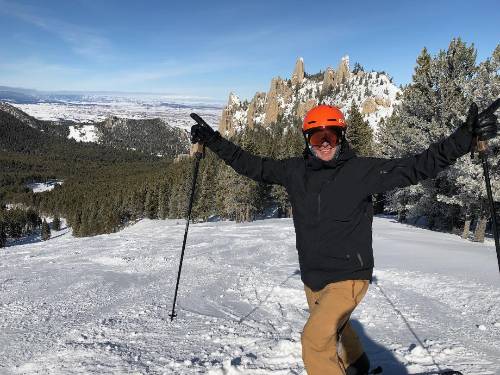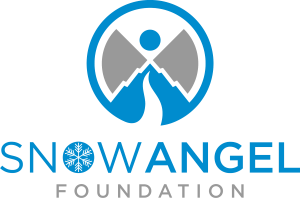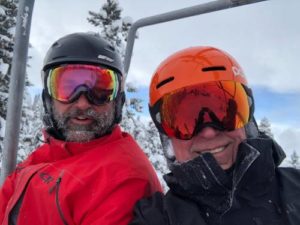
Have you felt it? A tectonic shift, a disturbance in the force, a change in the prevailing wind: whatever you call it, a life-long skier just like you or me is doing it. He’s fighting the big guys at their own game, and he’s doing just fine. Go Fish! Doug Fish that is, the founder of the Indy Pass.
Are you tired of paying to much for lift tickets? Are some of the largest resorts in North America just too expensive to bring your family for a vacation for a week? Or are you like us here at JF dotcom, full of wanderlust and wonder, looking forward to hitting the road and exploring? Then Indy Pass might be perfect for you.
In just three short seasons, and starting with Brundage Mountain in scenic Idaho, (thank you, Ken Rider!) Fish has compiled a line-up of 66 resorts throughout America. There’s mighty Cannon, stern Jay Peak, and historic Waterville Valley in the east. Out west there’s the aforementioned Brundage, gorgeous Red Lodge, and – how’s this for a cherry on the sundae – Powder Mountain in Utah, the newest addition and the largest resort acreage-wise in the U.S. And that’s part of their murderer’s row batting order. Indy Pass also features the best and largest slate of Midwest resorts, Lutsen Mountains in Minnesota, Granite Peak in Wisconsin, and Crystal Mountain Michigan. No other pass has more than three Midwest destinations, and some passes have none at all.
Through it all Doug Fish remains the same humble, grateful, and dedicated guy that started skiing as a kid at Mount Hood, and 55 seasons later has given back to the sport he loves in the biggest way. His imprimatur of exposing smaller independent mountains to a wider audience and helping them compete in the current era of mega pass consolidation has made him a hero of every winter sports enthusiast.
We caught up with Doug for a chat about Indy Pass, his career path, and a few other random topics that were just too much fun not to explore.
INTERVIEW WITH DOUG FISH, INDY PASS FOUNDER
JF: Tell us about your earliest memories of skiing.
DF: Well in 1963, I broke my leg right after my first chairlift ride at age 7. I was in the second grade, and my neighbors had twins my age. They invited me skiing with them for a week at Mt. Hood. We stayed on rope tow runs for a few days, but after that, they said, “Let’s go on the chairlift.” And sure enough I fell 100 yards from the top of the hill and snapped my leg at the ankle at the top of the boot.
(AUDIBLE GROANS OF PAIN…)
JF: How did you manage to break your leg 100 yards into the run?
DF: I didn’t know how to turn or stop, so I crashed! Lace up boots, cable bindings…I think my skis stayed on…Anyway, after that I was hooked! That cast was like a badge of honor! When you’re seven and you have a broken leg from skiing, how cool is that?!
(LAUGHTER)
JF: How long did it take to recover?
DF: A few weeks – normal time. Seven year-olds heal fast.
But after that, I had to go out on my own, since no one else in the family skied. I had to take the bus, so it was a few years later that I got into more on a regular basis. But I’d read the Sears catalog, and I’d dream about new ski gear.
When I hit my teens was when I started to ski a lot, and as a young adult I got much better, fairly accomplished. I finally had my own money to buy gear and lift tickets and what not. And then I started traveling a lot in my 30s. I was single, so I skied all over the west, from Whistler to Taos.
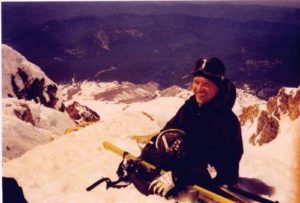
Jf: What were your favorites back then and why?
DF: My all time favorite to this day is still Alta. Then and now…it’s old school. The snow is amazing, the terrain is world class, and the lodge is vintage 1965 vibe. It’s just old school all the way.
And of course my home mountain, Mt. Hood, and that includes all three areas on Mt. Hood…Mt. Hood Meadows, Timberline, and Mt. Hood ski bowl.
JF: Take us down, frame by frame of one or two of your favorite runs of that heady, halcyon time.
DF: I don’t have a favorite run, but I have a favorite day. It was in the mid 80s and we were staying in Park City. We woke up, and the report said there was 8-10 inches of new at Alta. So we drove the hour to Alta, and when we go there, there was 30 inches of overnight of lake effect fluff…COLD SMOKE!!
So we take the chair up, first run of the day, the Collins chair it’s called and we traverse over to an open bowl that hadn’t been tracked yet. It was me and my buddy, and I dove in first on something called Columbine, and I went straight onto the rocks! Even with a 30 inch base we went right though it, the snow was so light I went all the way through to the base. I sank to the bottom! I went ass over teakettle! Okay, I said, not a good start, so we traversed over the to the middle of the bowl, and dove in again, and we had to hold our breath it was so deep and light. It was snorkel skiing without a snorkel. That was the best day of skiing of my life, and I still remember it to this day.
JF: How did you get your career started in the industry?
DF: I’ve owned marketing agencies for 40+ years and have specialized in ski resorts and related clients for 25 years. Before that, I worked in the concert biz for 17 years, 10 of which as the marketing guy for the largest promoter in Oregon. Learned how to market tickets, entertainment, shows, etc. and applied the same techniques to lift tickets and season passes years later.
JF: We’ll get to those “same techniques” in a minute or two, but as an entertainment lawyer, I’d be remiss if I didn’t ask you to tell us a few stories of your old rock and roll days. Regale us with come amusing stories from the green room.
DF: I was marketing guy for the largest concert promoter In Oregon (Double Tee Concerts). And by the way, the owner was a big golfer.
JF: I knew I’d be glad I asked about this…
(LAUGHTER)
DF: We worked with Bill Graham Productions; whenever they brought shows to Oregon, we’d co-promote with him. So as a result we did a lot of Grateful Dead shows.
JF: Oh, did you do any of the ones at Autzen Stadium?
DF: We did all the ones at Autzen Stadium, where the Oregon Ducks play. Oregon was a huge market for the Grateful Dead.
Those guys were great to work with, and the shows were always phenomenal. I met most of the band, and a couple years later Mickey Hart was promoting a tour of the Dalai Lama’s Tibetan Tantric Monks. They were on a goodwill tour for the Lama, and for the liberation of Tibet. Percussion was a part of the show along with the chanting. These were a couple dozen Buddhist monks, and they would do their chants – it was fascinating. I’ve seen hundreds of concerts, but this was one of the most unique, and Mickey Hart sponsored the tour.
So Mickey stayed at my house and crashed for a few hours He even left a roach on the nightstand table, so now I have a plaque at my house that says, “Mickey Hart slept here.”
JF: After some of the things I’ve written about post-Garcia Dead music, I shudder to think what he’d leave on my nightstand.
(LAUGHTER)
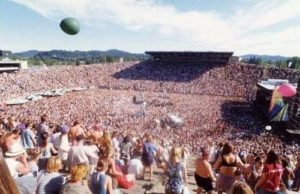

JF: Why Indy Pass?
DF: So I can ski for free.
(MORE LAUGHTER)
DF: When Ikon was announced in 2018 and we felt there were two gaps in the market: a pass for casual skiers and riders (averaging 4x per year) and a pass for small-to-mid-sized indies. We married the two together and Indy Pass was born. We call it the Indy Revolution.
JF: How do the member resorts benefit financially? How does revenue sharing work?
DF: We take 15% of pass revenue for overhead and marketing and the rest is returned to the resorts based on redemptions. The more visits a resort receives the more revenue they get. The per visit yield is paid out on a sliding scale pegged to the resorts’ holiday ticket price. The higher your ticket price the more you get for each visit. Our average holiday ticket is about $80.
JF: How did you select the mountains on the pass? What’s the application process like?
DF: We just started contacting resorts directly who we felt were in that small-to-midsized range with good reputations, terrain and facilities. About 1/3 of the resorts we’ve contacted have become partners. Many times resorts reach out to us and if it makes sense, we add them to the pass.
JF: Has anyone ever been turned down?
DF: Yes, we can’t have too many resorts in a region or we’ll start to cannibalize season pass sales.
JF: Who is the biggest name that’s turned you down?
DF: Pretty much every indie in Colorado and Lake Tahoe. Take your pick. I don’t want to name any names because I’m still working on getting them. We hold out hope every day.
JF: How much better a bargain is Indy Pass for eastern skiers? Western skiers? Does one or the other have an advantage?
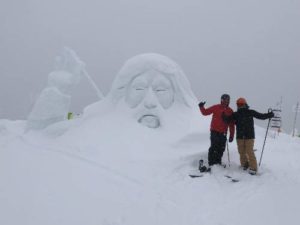
DF: Lift tickets are generally higher in the West but there is higher density in the East and Midwest. Based on our sales and redemptions the Northeast is our most popular market.
Our average adult passholder is age 37, and approximately 40% of our passholders are a family member of another passholder – a parent and a kid or two, or several kids, or the whole family. Also, 26% of our passholders have another pass, but this is not our primary target audience. And best of all we did what we set out to do: make skiing more affordable for the whole family. Now the whole family can ski more days, because of Indy Pass. They can take a vacation – or multiple vacations! – every year.
Every kid who wants to ski needs to experience an overnight or long trip. It’s a rite of passage. And the younger they experience it, the more they fall in love with it. The thrill of our sport itself is its own draws to a kid that age – waking up in that alpine environment…
JF: Even the anticipation of the night before or the drive up!
DF: Exactly! Now a family of four can tale care of all their ift tickets for weekends and vacations easily and inexpensively. For under $800, the whole family can ski for the entire season.
JF: What’s been the hardest selling point to the resorts, if any?
DF: Convincing them it will work, they won’t get ripped off, and it won’t cannibalize their pass products. Some resorts are also leery of joining a coalition with so many diverse resorts.
JF: What? Why?
DF: On Indy Pass there are a range of resorts, from tiny to quite large: from Antelope Butte in Wyoming to Powder Mountain in Utah, the largest in terms of acreage.
JF: Nice scoop, by the way…
DF: Thank you. And in terms of skier visits, by the way, our largest is Jay Peak.
JF: All the way up near the Canadian border!
[Author’s Note: We here at JF dotcom had an excellent two-day run there late this spring, and will have articles on Jay Peak after our coverage of this month’s U.S. Open golf championship.]
DF: Right. Jay Peak originally wasn’t even on our radar. I didn’t call them until the pandemic hit. I’d hoped that the Indy Pass might help them pick up more visits they might lose due to the border being closed. They came on board, and they became our number one resort in terms of visits. By Indy Pass standards, it’s a mega resort.
JF: Would you say that’s also because of the golf course, hotels, waterpark, and such?
DF: Yes, and the culture and history of the mountain, number of trails, the Tram. But also, Jay Peak is not self-conscious about being on a pass with Antelope Butte or a resort like Black Mountain in New Hampshire.
JF: And it’s far enough away from Magic Mountain – like 3-4 hours.
DF: Yes, and so they aren’t worried about a smaller resort diminishing their brand. In fact Cannon Mountain and Jay Peak joined Indy Pass to help smaller mountains gain notoriety and skier visits. They helped us sell a lot of passes and, consequently, generate a lot of revenue for places like Magic and Black Mountain.
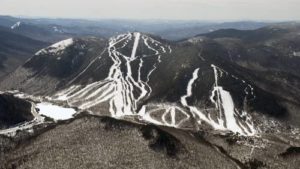
JF: And wasn’t Antelope rescued from the NLE file? No longer exists?
DF: Yes. Antelope was closed, mothballed, DOA for eight years, and now the community owns a non-profit run by volunteers, a great success story.
JF: How are you looking to improve Indy Pass?
DF: We hope to expand in areas of the US and Canada where we don’t currently have much density. We also will offer a robust lodging page on our website www.indyskipass.com this season with discounts for passholders. (Indianapolis Chamber of Commerce owns www.Indy Pass.com)
JF: Other than Covid, what’s been the biggest impediment to your selling even more Indy Passes?
DF: Getting the message out and educating people how the pass works and how much of a value it is.
JF: What constructive feedback are you getting from customers that you hadn’t thought about, but are good ideas you want to implement or fix?
DF: We are hoping to work on a special pass assurance program for Canadian buyers in case the border remains closed next season. But it doesn’t exist yet and we have no guarantee we’ll be successful at getting that, but we are going to try.
JF: Are mega-passes good for skiing? Do they, perhaps, sometimes hinder growth of the sport?
DF: I think all multiple-mountain passes are great for the sport. They have made it more affordable and encouraged people to travel further to go skiing and to visit new places. That’s the beauty of skiing – every mountain is different and provides a unique experience.
JF: Just like golf – every course is different.
DF: Exactly – Just like every course is a new adventure, so to is every new mountain an adventure. If you like exploration and discovery, that’s what multi-mountain passes are great for: variety, the spice of life.
JF: Do you have fears for the survival of mom and pop operations?
DF: If mom and pop ski resorts are well managed they should do just fine. Success for small areas is more and more dependent on good marketing, and some operators are just starting to catch up in that regard. Vail has an incredible marketing machine and a 10-year head start on utilizing very sophisticated digital marketing tactics. It’s not just about making snow and keeping the lifts running. You have to be a savvy marketer as well.
JF: Is it your experience that smaller mountains did a better job of adapting to Covid precautions and restrictions?
DF: I think all mountains adapted equally well, but the smaller hills were more appealing to a lot of people who didn’t want to fly, were re-entering the sport after X years off, or trying it for the first time. 20-21 saw an incredible influx of new people and an increase in frequency by existing skiers and riders. I’d say a majority of smaller resorts saw record skier visits.
JF: Do you have any protections in place to prevent larger corporate passes from poaching some of your higher end clients?
DF: If one of our resorts wants to join Epic or Ikon we wish them all the best and applaud that opportunity for them. No resort can be on two passes at the same time, so I suspect that will happen someday but for the most part, our resorts don’t work for Vail or Alterra. They don’t fit their profile.
JF: How bad a hit do you think the Indy Pass took with Covid, if any? How much business loss did lockdowns cause you to sustain?
DF: Honestly, COVID created very favorable business conditions for the ski business and Indy Pass went along for the ride. COVID-19 as it turns out was the best thing to hit the ski industry since snowmaking.
JF: Even with the massive loss of spring 2020?
DF: Yes, because it opened people eyes to outdoor recreation – not just skiing but all outdoor recreation.
JF: Golf flourished. Rounds were up 18% nationally.
DF: Yes. So did sport fishing, boating, camping, hiking, climbing – anything that got people outdoors benefited from this new awareness of how boring it is to sit at home on the couch.
So we saw it coming last summer, and in the winter, there’s not much to do except ski and snowboard. So in winter everyone turned to skiing and said “Let’s dust off those rusty strings just one more time. Gonna make ’em shine.”
JF: I get the musical reference there, Mr. Garcia…
(LAUGHTER)
JF: Besides Indy Pass what other winter sports activities are you involved with?
DF: My agency, Fish Marketing works with Subaru of America on ski resort tie-ins in Colorado, Last Tahoe and Oregon. We also produce a get-stoked, kickoff festival in Portland called Snowvana in late November and we work with a variety of resorts around the U.S. on marketing programs. I have not worked in the day-to-day operations at the agency for over two years, however. It is run by my partner, Nate Parr who also oversees marketing for the Indy Pass.
JF: Favorite east coast trails?
DF: I skied the northeast for the first and only time in February 2020, and enjoyed every mountain I visited for different reasons. My favorite Indy Pass resorts were Cannon and Bolton Valley, and for non-Indy Passers I would have to say Smugglers Notch.
JF: Have you thought of mini tours? As in “hit these three and stay n this town?” Like a trip recommender?
DF: The folks on our Passholders Facebook Group have dozens of recommended tours, and the media has been very helpful in describing several great loops. Honestly, there are so many combinations of mini-tours that one can put together, it’s almost impossible to recommend one. I would add that flying into Seattle, Spokane, Boise, Salt Lake, Minneapolis, Boston or Burlington would present quite a few juicy options.
JF: What’s next for Indy Pass?
DF: We will continue to spread the word about the “Indy Revolution” and our partner resorts and keep adding resorts in regions where we have gaps.


